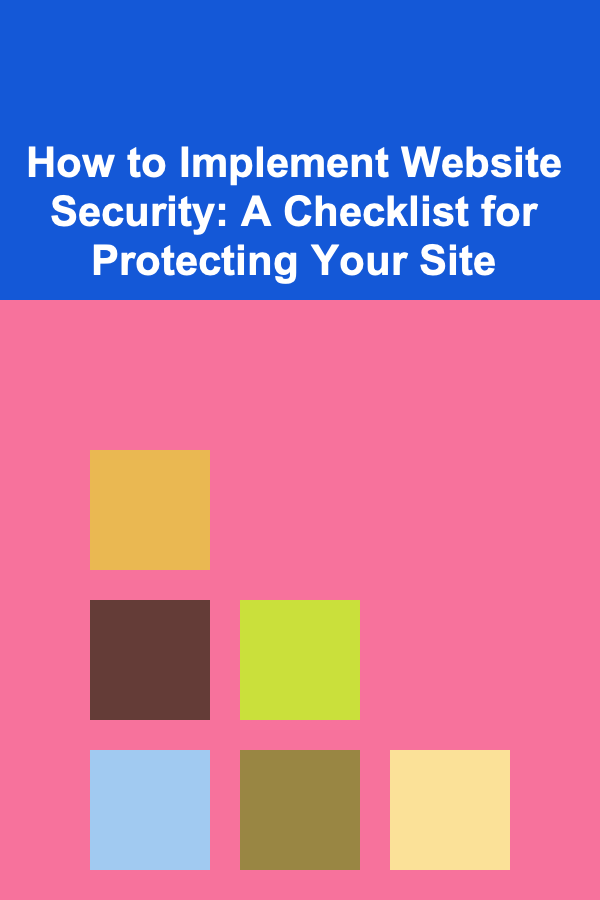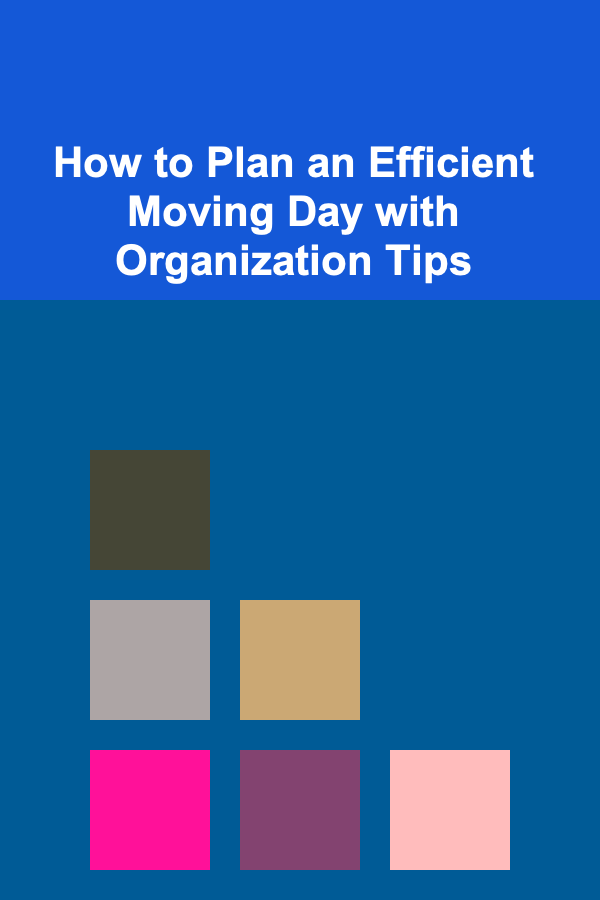
How to Implement Website Security: A Checklist for Protecting Your Site
ebook include PDF & Audio bundle (Micro Guide)
$12.99$5.99
Limited Time Offer! Order within the next:

Website security is one of the most critical aspects of managing an online presence. As cyber threats become more sophisticated, ensuring the security of your website isn't just a best practice---it's a necessity. From protecting sensitive customer data to maintaining your site's integrity and trustworthiness, securing your website is an ongoing process that demands attention to detail. In this guide, we'll walk you through actionable steps you can take to safeguard your website and minimize risks.
Keep Software and Plugins Up to Date
Why It's Important
Outdated software is one of the most common vulnerabilities on the web. Many hackers exploit known flaws in outdated software and plugins to gain unauthorized access to a site. Keeping your website's software updated---whether it's a content management system (CMS), plugins, or server software---is your first line of defense.
Action Steps
- Enable Automatic Updates: Many CMS platforms, like WordPress, allow automatic updates for core files and plugins. If possible, enable this feature to stay on top of critical patches.
- Monitor Updates: If automatic updates aren't an option, designate someone to monitor updates for your software and plugins. Always apply updates as soon as they become available.
- Remove Unused Plugins and Themes: Any plugins or themes that you are not using should be deleted. These can introduce unnecessary security risks.
Use Strong Passwords and Multi-Factor Authentication (MFA)
Why It's Important
A common point of entry for attackers is weak or easily guessed passwords. To protect your site, use strong passwords combined with MFA wherever possible to add an additional layer of security.
Action Steps
- Create Strong Passwords: Ensure all admin, user, and FTP accounts have strong, unique passwords. Use a combination of upper- and lower-case letters, numbers, and special characters.
- Use Password Managers: A password manager can help store and generate secure passwords, making it easier to maintain strong credentials.
- Enable Multi-Factor Authentication: Activate MFA for all accounts that support it, including your CMS, hosting provider, and other critical services. This adds an extra barrier, requiring both a password and a second form of verification (e.g., a text message or authentication app).
Install an SSL Certificate (HTTPS)
Why It's Important
SSL (Secure Sockets Layer) certificates encrypt the data exchanged between the user's browser and your server. This protects sensitive information, like login credentials and payment details, from being intercepted by attackers.
Action Steps
- Get an SSL Certificate: Purchase and install an SSL certificate for your website. Many hosting providers offer free SSL certificates through Let's Encrypt.
- Force HTTPS: Ensure all website traffic is encrypted by redirecting HTTP requests to HTTPS. This can be done through your web server's configuration or by using a plugin if you're on a CMS like WordPress.
Implement Web Application Firewalls (WAF)
Why It's Important
A Web Application Firewall (WAF) helps protect your website from various threats, including SQL injections, cross-site scripting (XSS), and other malicious attacks. WAFs filter out malicious traffic before it reaches your server.
Action Steps
- Choose a WAF: Research WAF services that fit your needs. Some popular options include Cloudflare, Sucuri, and AWS WAF.
- Configure the WAF: Once installed, ensure your WAF is configured to block malicious traffic and alert you to potential threats.
Regular Backups
Why It's Important
Regular backups are crucial for restoring your website in case of data loss due to a cyberattack or server failure. Without a backup, recovery could be extremely costly or impossible.
Action Steps
- Schedule Automated Backups: Use a backup plugin or service to create regular backups of your website, including databases and media files.
- Store Backups Offsite: Don't store your backups on the same server as your website. Use external storage options like cloud storage (e.g., Google Drive, Dropbox) or offsite servers for added safety.
- Test Backup Restores: Periodically test your backups to ensure they're functional and can be restored without issues.
Monitor and Audit Website Traffic
Why It's Important
Continuous monitoring of your website's traffic and activity can help you detect suspicious behavior early. By analyzing website logs, you can spot unauthorized attempts to access your site and take action before an attack succeeds.
Action Steps
- Use Security Plugins: Many security plugins (e.g., Wordfence for WordPress) offer traffic monitoring features that alert you to suspicious activity like brute-force login attempts or excessive failed login attempts.
- Check Logs Regularly: Frequently review your server logs and CMS logs for any unusual activity, such as spikes in traffic or failed login attempts.
- Set Up Alerts: Set up email or SMS alerts for any unusual behavior, such as multiple failed login attempts or large bursts of traffic.
Limit User Access and Permissions
Why It's Important
Not every user on your website should have access to everything. Limiting user permissions reduces the chances of someone inadvertently---or intentionally---causing harm to your site.
Action Steps
- Use the Principle of Least Privilege: Give users only the permissions they need to perform their tasks. For example, an editor doesn't need access to your website's core settings.
- Regularly Review User Permissions: Over time, some users may not need the same level of access they once did. Regularly audit user roles and permissions to ensure they are still appropriate.
- Implement Role-Based Access Control: If possible, set up role-based access to segregate tasks among users (e.g., administrators, editors, contributors) so that higher-level permissions are reserved for trusted individuals.
Secure Your Server and Hosting Environment
Why It's Important
Your hosting environment is a critical part of your website's security. A vulnerable server can leave your website exposed, even if your website's software is up to date.
Action Steps
- Choose a Reputable Hosting Provider: Ensure that your hosting provider has robust security measures in place, such as firewalls, regular security patches, and backups.
- Configure Your Server Correctly: Disable unused ports and services, configure strong server-level firewalls, and ensure that only authorized users have access to the server.
- Use Secure File Permissions: Set correct file permissions on your server to restrict unauthorized users from accessing sensitive files. For example, files should be set to read-only, and executable files should be carefully controlled.
Use Content Security Policy (CSP)
Why It's Important
A Content Security Policy (CSP) helps prevent a variety of attacks, including Cross-Site Scripting (XSS) and data injection attacks. By specifying which sources of content are trusted, CSP reduces the risk of malicious content being loaded on your site.
Action Steps
- Configure CSP Headers: Add CSP headers to your HTTP response to specify trusted content sources, such as scripts, stylesheets, and images.
- Test Your CSP: Use tools like the CSP Evaluator or the Content Security Policy Generator to ensure your policy is correctly configured and won't accidentally block legitimate resources.
Educate Your Team and Stay Informed
Why It's Important
Human error is a major vulnerability in website security. If your team isn't educated on best security practices, even the most secure website can be compromised.
Action Steps
- Train Your Team: Regularly provide security training for anyone who manages the website. This includes understanding password best practices, recognizing phishing attempts, and following secure coding practices.
- Stay Updated on Security Threats: Subscribe to security blogs, forums, and newsletters to keep up with the latest threats and vulnerabilities. Websites like the US-CERT (United States Computer Emergency Readiness Team) or SANS Institute offer valuable resources.
Conclusion
Website security is an ongoing process that requires constant vigilance. By following this checklist and regularly updating your security measures, you can significantly reduce the risk of a cyberattack and protect your site, your data, and your users. Remember, no website is immune to threats, but with the right strategies in place, you can minimize vulnerabilities and create a safer online environment.

Craftsmanship in Audio: A Deep Dive into the Art of Sound Production
Read More
How to Create a Backyard Movie Theater for Family Fun
Read More
How to Create a Home Office Storage System for Productivity
Read More
How to Create a System for Storing Seasonal Decorations
Read More
How to Plan an Efficient Moving Day with Organization Tips
Read More
How to Use Bookends and Decorative Items for Organization
Read MoreOther Products

Craftsmanship in Audio: A Deep Dive into the Art of Sound Production
Read More
How to Create a Backyard Movie Theater for Family Fun
Read More
How to Create a Home Office Storage System for Productivity
Read More
How to Create a System for Storing Seasonal Decorations
Read More
How to Plan an Efficient Moving Day with Organization Tips
Read More